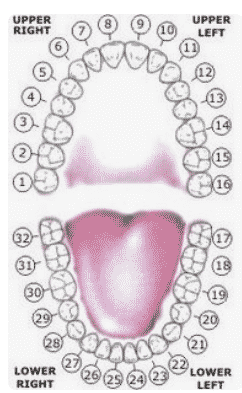
However, during that same time period the total number of dental procedures increased from about 516 million in 1999 to about 548 million in 2009 (figure 1). Overall, the percentage of the population receiving dental care remained unchanged between 19 (43.1 percent in 1999 and 42.2 percent in 2009).
TEETH NUMBERS USA UPDATE
These estimates update information previously published in Chartbook #17, Dental Use, Expenses, Dental Coverage, and Changes, 19. In calculating the distribution of visits with particular services, visits for which the respondent reported more than one type of procedure (an examination and a cleaning, for instance) are counted twice-once in each category. Service types not identified by respondents are not included. Multiple procedures of the same type at the same visit are not counted. In this Brief, procedures refer to at least one procedure type per visit. Only differences that are statistically significant at the 0.05 level are discussed in the text. All estimates are for the United States civilian noninstitutionalized (community) population. Estimates are presented on overall use of dental services as well as estimates of the distribution of visits for particular dental services. This Statistical Brief uses data from the Household Component of the 19 Medical Expenditure Panel Survey (MEPS-HC) to examine changes in the receipt of dental care over that decade. Dental care includes diagnostic, preventive, restorative, prosthetic, endodontic, and orthodontic care.

Maintaining oral health is important not only to support healthy teeth and gums, but is an integral part of one’s overall health and prevention of disease and disability. Overall people were more likely to have at least one preventive procedure and less likely to have one restorative procedure in 2009 than in 1999.ĭental care is an important component of overall health care. Overall, as a percentage of all procedures, diagnostic and preventive procedures increased while restorative, prosthetic, endodontic, and orthodontic procedures decreased from 1999 to 2009.

The total number of dental procedures increased from about 516 million in 1999 to about 548 million in 2009. This compares to 43.1 percent with at least one dental visit in 1999.
TEETH NUMBERS USA PROFESSIONAL
Overall, 42.2 percent of the population had at least one visit to a dentist or dental professional during 2009. Manski, DDS, MBA, PhD and Erwin Brown, Jr., BS Visit the dentist every six months: Regular dental visits are important in order to catch any problems early and to keep your teeth healthy! They can also provide cleanings that are more thorough than what you can do at home.Richard J.Be sure to hug the curve of each tooth as you floss and go slightly under the gumline. Floss ATLEAST every day (But recommended twice a day): Flossing removes plaque and germs from between your teeth, helping to prevent cavities between teeth.Be sure to brush all teeth surfaces, including near the gum line, and pay attention to your back teeth. Brush your teeth twice a day with fluoride toothpaste: Flouride is a mineral that helps to remineralize your teeth and prevent cavities.
TEETH NUMBERS USA HOW TO
Here are a few tips on how to clean your incisor teeth: Your incisors, just like every other tooth, are vital to proper oral health and it is important to take care of them! Not cleaning them properly can lead to cavities, gum disease, and eventually tooth loss. Its function is to provide nutrients and sensation to the tooth.

Its function is to protect the tooth from chewing and biting forces. It is also the hardest substance in the human body.

Like all teeth, incisors have two main parts: the crown and the root.


 0 kommentar(er)
0 kommentar(er)
